2 U.S. troops killed in latest copter crash
BAGHDAD — A U.S. military helicopter crashed amid heavy gunfire Friday north of Baghdad, police and witnesses said -- the fourth American chopper to go down in two weeks. The U.S. military said two crew members were killed.
The spate of attacks raised questions about whether insurgents were increasingly targeting aircraft, a crucial component of U.S. operations in Iraq. Not only do U.S. forces rely on helicopters in combat, but they are being used more often to ferry personnel and equipment across the country to avoid roadside bombs, the major killer of U.S. troops.
The recent attacks on helicopters have inflicted a heavy toll on Americans in Iraq -- 16 military personnel and five civilians killed -- at a time when roadside bombings are becoming less effective against U.S. vehicles, which are protected by improved armor plating, signal-jamming devices and other measures.
Six other U.S. military personnel in Iraq died in the previous two days, two in combat in Al Anbar province, one of an apparent heart attack and three in vehicle accidents, the U.S. command said. At least 3,093 U.S. personnel have been killed in the Iraq theater since the 2003 U.S.-led invasion, according to the website icasualties.org.The U.S. military has lost 54 helicopters in Iraq since May 2003, about half of them to enemy fire, according to figures compiled by the Washington-based Brookings Institution.
Marine Gen. Peter Pace, chairman of the Joint Chiefs of Staff, acknowledged that insurgent ground fire in Iraq had been “more effective against our helicopters in the last couple of weeks.”
But he said it was unclear whether “this is just statistically what’s going to happen over time when you’re flying at that level and people are shooting at you, or if there are some kind of new tactics and techniques that we need to adjust to.”
“The folks on the ground are looking at that right now,” Pace told journalists at a Pentagon briefing.
The U.S. command, in a brief statement, did not identify the latest helicopter felled or detail the circumstances of the crash.
Iraqi police and witnesses said the aircraft was shot down over farmland near Taji, a major U.S. air base about 10 miles north of Baghdad.
Hashim Assafi, a 37-year-old farmer, said he was irrigating his field when he saw a pair of helicopters fly by and heard a burst of gunfire, sending him ducking behind a well for cover. One helicopter was hit but continued flying, he said.
Peeping out from behind the well, he said, he watched the other helicopter circle back to where the gunfire had come from. There was another burst of fire, which he said hit the second craft in the tail.
“I saw smoke coming out of the tail,” he said. “The chopper was swinging around before it hit the ground one kilometer away from me, and I heard a big explosion.”
Other witnesses, who said the helicopters were escorting a convoy of military vehicles, described seeing a ball of fire as the stricken aircraft hit the ground.
U.S. troops sealed off the area and additional helicopters circled overhead, police and witnesses said.
A group linked to Al Qaeda claimed responsibility for the attack in a statement posted on a militant website.
“We say to the enemies of God that the sky of the Islamic state of Iraq is forbidden just like its land,” the statement said, adding that the group had “new ways” to attack helicopters. It was not possible to verify the authenticity of the statement.
Military analysts said the recent cluster of attacks was worrying, but cautioned that it was too early to confirm a trend.
“The insurgents constantly improve and adapt their methods,” said Anthony Cordesman, a former Defense Department official who is a military expert at the Center for Strategic and International Studies in Washington.
“There may well be a change in tactics to focus on helicopters because they are the principal method of transportation as well as an important attack element.... The problem is that we don’t have enough of a pattern yet to be sure,” he said.
Two other military helicopters and a civilian helicopter have been lost since Jan. 20. All were believed to have been shot down in combat or in areas where Sunni Muslim-led insurgents were active, though the causes of the crashes are still officially under investigation.
One of the military helicopters went down Sunday near Najaf during an offensive by American and Iraqi forces against a violent messianic cult said to be plotting attacks against Shiite Muslim clerics and religious sites. Two crew members were killed.
The other military chopper was a Black Hawk that crashed two weeks ago near Baqubah, killing all 12 U.S. personnel aboard, including three officers and two command sergeants. And five Western security contractors employed by North Carolina-based Blackwater USA were killed when two helicopters came under attack Jan. 23 in Baghdad and one of them crashed.
Sunni-led insurgents and Shiite militias are known to have shoulder-fired SA-7 antiaircraft missiles, rocket-propelled grenades and heavy machine guns in their arsenals.
The U.S. military has developed tactics to minimize the risk. Routes are varied. Helicopters fly low and fast to make it difficult for gunmen to get them in their sights, and they drop flares to divert heat-seeking surface-to-air missiles.
Such countermeasures are reevaluated after every copter crash, said Col. Bryan Owens, commander of the 3rd Brigade Combat Team, 82nd Airborne Division, who was questioned about Friday’s crash during a separate Pentagon briefing.
“It didn’t happen in my area, but I fully expect that the lessons learned from the tragedy of helicopter crashes will be passed on to me so that we can take action in our area just to make sure that we are ... not putting our soldiers at undue risk,” said Owens, who spoke to journalists via teleconference from Tikrit, northwest of Baghdad.
In other violence, police recovered at least 15 bodies in Baghdad, apparent victims of sectarian death squads.
U.S. forces said they killed at least 18 suspected insurgents in two missile strikes during fierce clashes late Thursday and early Friday in Ramadi, a Sunni Arab insurgent stronghold in volatile Al Anbar, west of Baghdad. There were no immediate reports of U.S. military or Iraqi civilian casualties in the Ramadi clashes.
Also in Al Anbar, the municipal council chairman in Fallouja was killed in a drive-by shooting as he left his home to attend Friday afternoon prayers, authorities said.
South of Baghdad, three days of mourning were announced for the 73 people killed and 152 injured in twin bombings Thursday at a busy Shiite market in the heart of Hillah.
In Najaf, authorities imposed a daytime vehicle ban amid fears that surviving members of the Heaven’s Army cult, the target of Sunday’s U.S.-Iraqi offensive outside the city, were again planning attacks.
The city has been on edge since the weekend clash, when more than 200 cult members were killed and hundreds detained.
Times staff writers Julian E. Barnes and Saif Rasheed in Baghdad and special correspondents in Baqubah, Hillah, Najaf and Taji contributed to this report.
More to Read
Sign up for Essential California
The most important California stories and recommendations in your inbox every morning.
You may occasionally receive promotional content from the Los Angeles Times.










